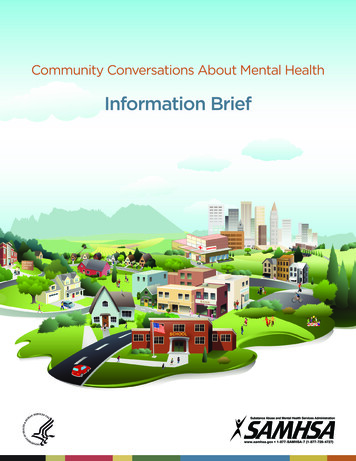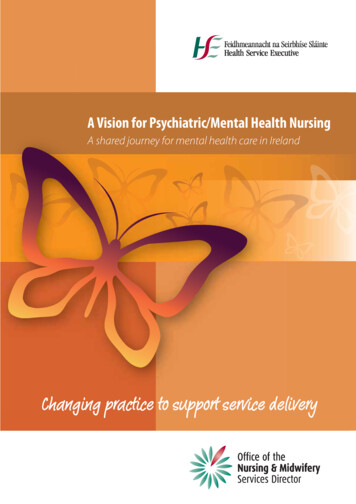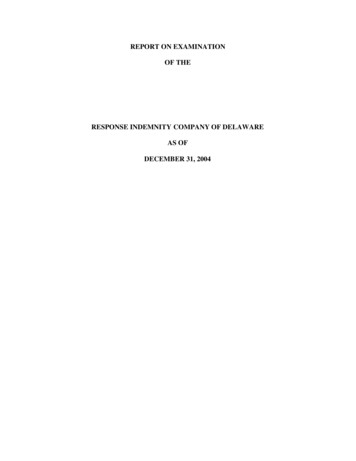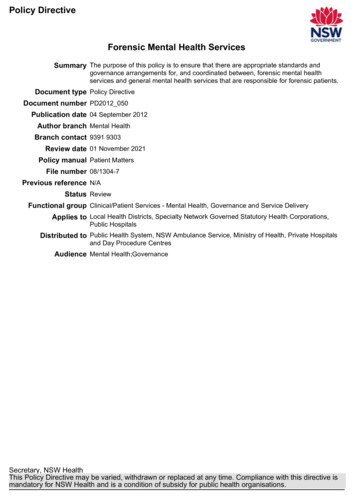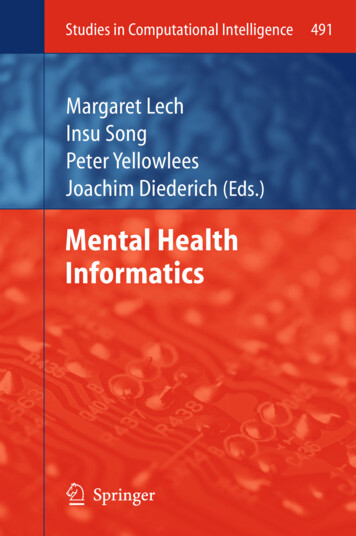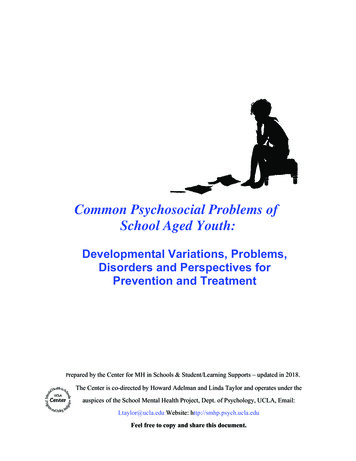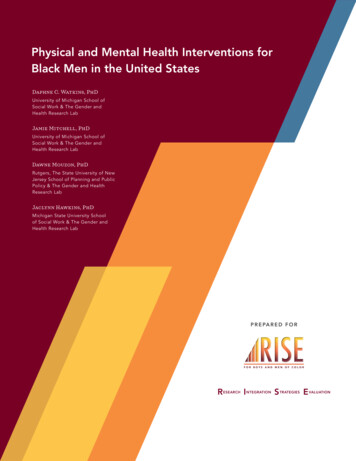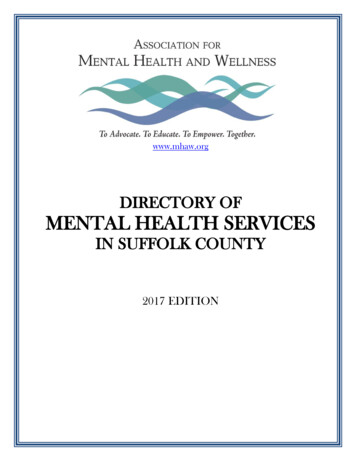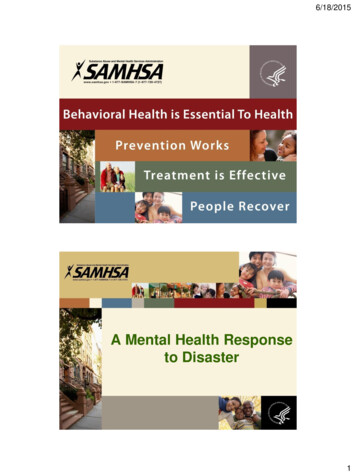
Transcription
6/18/2015A Mental Health Responseto Disaster1
6/18/2015American Red CrossDisaster Mental HealthAgenda American Red Cross – Overview of Servicesand Structure Psychological Impacts of Disaster Disaster Mental Health – Overview andInterventions2
6/18/2015American Red Cross Non-profit humanitarian organization U.S. Congressional Charter Guided by seven fundamentalprinciples: HumanityImpartialityNeutralityIndependence Voluntary service Unity UniversalityAmerican Red CrossCore Business Lines Disaster Cycle ServicesService to the Armed ForcesHealth and Safety Training & EducationBlood ServicesInternational Services3
6/18/2015Disaster Cycle ServicesAmerican Red CrossDisaster Relief Services Food and WaterShelterDirect Client AssistanceDisaster Health ServicesDisaster Mental Health ServicesDisaster Spiritual Care ServicesReunification ServicesDistribution of Relief SuppliesInformation and ReferralsRecovery casework4
6/18/2015Division Structure (7)Region Structure (62)5
6/18/2015Staff Structure - DivisionVolunteers make up morethan 90% of the RedCross disaster workforce.Staff Structure - RegionVolunteers make up morethan 90% of the RedCross disaster workforce.6
6/18/2015Psychological Impacts of Disaster Vary widely Dependent on individual factors, such asage, culture, previous functioning, etc. Occur in all domains of functioning ological Impacts of Disaster Many people are resilient and will naturally return totheir pre-disaster level of functioning This is the most common outcome Over 50% of population resilient after 9/11 On average, 30-40% of direct victims of disaster willexperience one or more disorders such as PTSD,depression or anxiety Children emerge with greater risk 5-10% of people in the community-at-large 10-20% of responders are at risk Early intervention reduces riskGalea, S., Nandi, A., & Vlahov, D. (2005) The epidemiology of post-traumaticstress disorder after disaster. Epidemiologic Reviews, 27, 78-91.7
6/18/2015Disaster Response PhasesMyers and Zunin, 1990; DHHS, 2000 & 2004; Herrmann, 2004American Red CrossMission of Disaster Mental HealthTo provide mental health support todisaster survivors and respondersacross the disaster continuumof preparedness, response and recovery.8
6/18/2015Disaster Mental Health 3,500 independently-licensed, master’s level(or higher) mental health professionals,including: PsychologistsClinical Social WorkersMarriage and Family TherapistsLicensed Professional CounselorsSchool PsychologistsSchool CounselorsPsychiatric NursesPsychiatristsDisaster Mental Healthin Preparedness Community-based, resilience-buildingeducation models:Examples: Coping in Today’s World: Psychological First Aidand Resilience for Families, Friends andNeighbors Pillowcase Project – school-based disasterpreparedness curriculum for elementary schoolstudents Psychological First Aid - training for Red Crossdisaster responders9
6/18/2015Disaster Mental Health ResponseThree-Element Intervention StrategyElement 1:Identification of Mental Health NeedsGoal 1 - Triage disaster survivors Red Cross Disaster Mental Health utilizes PsySTARTtriage system based on evidence-based risk factors: Exposure to disaster – e.g. Impact on self, family,pets, home, belongings and financial security Previous history of mental illness Previous disaster experience Individual resilience10
6/18/2015Element 1:Identification of Mental Health NeedsOther instances requiring Disaster Mental Healthintervention include clients who present withsignificant stress symptoms: A person is crying uncontrollably, withdraws over anextended period, or otherwise exhibits significant distress; A client is so distressed or has extreme limitations thatrequire advocacy to get through the interview with thecaseworker or access other critical disaster services; A client or worker behaves in such a way that makes itdifficult for the service provider to provide services; A distressed worker or client asks for coping support, orhas it requested for them by someone else.PsySTART Wallet Card11
6/18/2015PsySTART Risk Factors Risk factors are used as a first step in a continuum oftriage, screening, secondary clinical assessment, andreferral Developed by Red Cross Disaster Mental HealthResponder and disaster research psychologist Based on multiple research studies on children andadults: Direct research using PsySTART itself (Theinkurta, et. al. 2006,Marshal et. al. 2008) Large scale reviews of DMH literature: (Norris, et al, 2001,Galea, 2005, Neuria, 2008, Digrande, 2011) Meta-analytic reviews of PTSD risk following traumatic events(Ozer, 2003, Brewin, 2000)Element 1:Identification of Mental Health NeedsGoal 2 - Mental Health Surveillance Purpose: To deploy to areas with higher ratios of high riskclients To inform state and local MH agencies of client needs To monitor worker exposure Process: Supervisor/manager collects data from DMHworkers and aggregates to determine areas with higherrisk12
6/18/2015Example of Mental HealthSurveillanceElement 2:Promote Resilience and CopingEnhanced Psychological First Aid Make a connection Help people be safe Be kind, calm andcompassionate Meet basic needs Listen Give realistic reassurance Individual psychoeducation Encourage good coping Help people connect Give accurate and timelyinformation Make a referral to aDisaster Mental Healthworker End the conversation Take care of yourself13
6/18/2015Element 2:Promote Resilience and Coping Public health messaging and consultationHelp communities normalize stress reactions afterdisaster Examples: Bus advertisements, Public ServiceAnnouncements Support state and local mental healthagencies/professionals through training andconsultation Community resilience trainingElement 3:Targeted Disaster Mental Health Interventions Secondary assessmentReferrals to community resourcesCrisis InterventionCasualty supportAdvocacy14
6/18/2015Disaster Mental HealthDisaster Mental Health RespondersDo NOT Do: PsychotherapyFormal mental health evaluations or diagnosisIndividual psychological debriefings (e.g., CISD)Long-term trauma therapiesWhy Not? Focus is short term Building strong therapeutic alliance is notappropriate Some interventions have concerns about efficacy orsecondary trauma Best time to talk is when you feel like it, notnecessarily when a group debriefing is scheduled Lack of pre-screening can be problematic for groups15
6/18/2015Disaster Mental Healthin Recovery Continued assessment and support of disasteraffected community, first responders and Red Crossworkforce Participate on Long Term Recovery Groups toidentify and assist in filling service delivery gaps Public health messaging and consultation Support state and local mental healthagencies/professionals through training andconsultation Community resilience trainingWhen to UtilizeDisaster Mental Health Responders All size disasters – house fires to hurricanesLarge number of displaced survivorsOne or more fatalitiesHigh-risk populations involved: Children Elderly Survivors with Accessand Functional Needs High levels ofresponder stress Transportation/AviationIncidents16
6/18/2015For More Information:J. Christie Wrightson, MSW, LICSWSenior Associate, Disaster Mental HealthAmerican Red Cross National Headquarterschristie.wrightson@redcross.orgFind your local Red Cross chapter:www.redcross.orgDisaster Distress HelplineOverview, Discussion, Q&A17
6/18/2015Agenda Disaster Distress Helpline & Behavioral Health Overview of DDH Services Additional Resources Discussion / Q&ADisaster Behavioral HealthMentalHealthConcerns DisasterPre-existing mental/behavioral health concerns aggravated, triggered by eventNew behavioral health concerns emerge after eventAccess to care affected by eventSpecial considerations for individuals & families with access and functional needs18
6/18/2015Distress Risk FactorsWho is most at risk for distress? Survivors living or working in impacted areas: higher degree ofexposure, greater the risk for distress or trauma (“circle of impact”) Loved ones of victims (traumatic loss) First responders, rescue & recovery workers; disaster relief &emergency workersOther considerations: Pre-disaster mental health concerns History of challenging or difficult recovery from past disasters Pre-disaster experience of family violence, domestic violence, sexualviolence, other issues of crime/victimization Access & functional needs Media exposure (inside/outside impacted areas)Distress ReactionsDisaster Distress: Norris, 2002: 9% minimal reactions; 51% moderate; 23% severe; 17% very severePossible Distress Reactions Include:Mild to Moderate (Transitory) Severe to Very Severe (Psychopathology) Trouble sleeping Difficulty concentrating and performing daily tasks, including at work or school Irritability; increased feelings of worry and anger Withdrawal and isolation Feelings of hopelessness Setbacks during anniversaries, other event reminders Increased substance use; risk for abuse or addiction Persistent anxiety Depression; suicidal thoughts, ideation, attemptAlso: Post-Traumatic Growth19
6/18/2015Research The occurrence of natural and man-made disasters increased in the U.S and itsterritories by 39% from 2000-20101 The psychological impact these events have on a significant proportion of peoplewho experience them2 Demonstrates the need for a hotline network with the capacity to provide disastercrisis counseling and emotional support in any part of the country with immediacy. Five intervention principles3 following disasters to promote among those affected:1) Sense of safety2) Calming3) Sense of self– and collective efficacy4) Connectedness5) Hope1: http://www.fema.gov/news/disaster totals annual.fema2: Norris, F.H., Friedman, M.J. and Watson, P.J. 60,000 Disaster Victims Speak: Part II. Summary and Implicationsof the Disaster Mental Health Research, Psychiatry 65(3) Fall 2002 2403: Hobfoll, S.E., Watson, P., Bell, C.C., et. al. Five Essential Elements of Immediate and Mid–Term Mass TraumaIntervention: Empirical Evidence, Psychiatry 70(4) Winter 2007 pp285-286DDH: Public/Private Partnership HHS / SAMHSA Link2Health Solutions- National Suicide Prevention Lifeline- Veterans Crisis Line- Oil Spill Distress Helpline MHA-NYC- 9/11 Terrorist Attacks, Hurricane Katrina- Project Liberty & Project Hope20
6/18/2015DDH: Overview of Services National hotline (1-800-985-5990) and SMS (text ‘TalkWithUs’ to 66746)service available to anyone in the U.S. states/territories before, during& after natural and human-caused disasters Goal: To assist individuals and families experiencing emotionaldistress related to disaster, in order to help them move forward on thepath to recoveryAlso: Complements existing local / state / national - I & R / crisis hotlines Multi-lingual interpretation services in 100 languages; live 24/7 crisiscounseling in Spanish available via the hotline and SMS (text‘Hablanos’ to 66746) Hotline available to all U.S. territories: Pacific Islands can text“TalkWithUs” or “Hablanos” to 1-206-430-1097 & Caribbean Islands to1-212-461-4635 TTY (1-800-846-8517) available, and texting also promotedto deaf and hard of hearingDDH: When Someone Calls or Texts Psychological First Aid- NCTSN PFA Online http://learn.nctsn.org Disaster Crisis Counseling for Crisis Contact PsychoEducationValidationUsing Normalization Crisis Assessment, Intervention and Referral Guiding Principles21
6/18/2015Sample DDH Caller Scenarios**Names, other identifying information changed or omitted for confidentiality 12/2012, MI – Caller is struggling related to the shootings in CT. Caller hasa history of anxiety and was last in treatment a year ago. Caller stated thatshe has two small children and she has felt overwhelmed with anxiety andfear since the shootings. She is able to confide in her mother and herhusband, but is frustrated that their suggestions to occupy her time andstay away from news programming are not helping. 4/2013, MA – Caller reports being a runner at the Boston Marathon andwas at the finish line, a minute after the bombing took place. He considershimself very lucky but is having a hard time coping with the trauma. Hestates that his wife was also running but left the course midway and hewas not able to communicate or reunite with her until much later. 3/2014, WA – Middle-aged caller residing near the area impacted by theWashington State landslide reported feelings of sadness and grief, as aneighbor had died in the landslide. The caller also indicated feelings offrustration as [she/he] could not engage in [her/his] usual activities as theroads in the area had been closed off. These feelings had also beenexacerbated by the recent death of a family member.DDH: Why Offer Texting?Prevalence of mobile phones, SMS/TextingStudy: preferred method of communication for teens, increasingly alsofor adultsGrowing form of outreach and engagement for other Helplines andsocial servicesOpportunities to reach individuals whom otherwise may go unnoticedEngaging individuals in circumstances when they can’t make phonecalls (anonymity, safety)Best practices in Emergency Preparedness and Response22
6/18/2015Sample DDH Texter Scenarios**Transcribed directly, so misspellings/grammar intentional; identifying information changed or omitted for confidentiality Things have been difficult and very stressful. I lost everything during Katrina and stilldeal with the emotions of that daily and now having to deal with this again and on theanniversary of it just makes things even more emotional. No one really seems tounderstand why I am so emotional about the situation! In Katrina I swam and our homewashed away! Even where we evacuated to had 18 feet and swam to a roof top. Its justbeen really hard to deal with I'm having panic attacks and freaking out about this hurricane coming. I just can notseem to focus and push the storm back for a bit to get myself back in control Do u think [town] will get hit hard kuz i live in a old trailer and have 3 kids so i wanted 2know if i need 2 leave thanks I was really looking for advice about where to go. Im handling my fears fine just trying tofind a safe place for me and my family. Trying to be prepared Evac from [city], daughter need dialysis, mom elderly they not getting along is driving meto tears. I want to go home! Need to talk to someone . Need help!!!DDH: Key PlayersSAMHSA Funder & keyfederal partnerLink2HealthSolutionsCore RegionCenters (CRCs)Affected AreaCenters (AACs)* Administrator, asubsidiary of thenon-profit MHANYC; alsoadministers theNational SuicidePreventionLifeline network Crisis ContactCenters thatcomprise theDDH Network TemporaryNetwork CrisisContact Centerslocated indisasterimpacted areasKey Stakeholders Agencies,Institutions,Organizationsthat servedisasterimpactedcommunities23
6/18/2015DDH Core Region CentersDDH: Additional ServicesOutreachTrainingResourcesCommunications24
6/18/2015Outreach & TrainingOutreach- Identify key stakeholders- Develop relationships- Network & coordinate services throughout all phases of a disaster- Via stakeholders, promote the DDH to disaster survivors, loved ones, firstresponders, rescue & recovery workers (self-care resource)- Advocate for inclusion of disaster behavioral health needs/servicesTraining and Technical Assistance- Training & TA provided for DDH-networked ‘Core Region Centers’ and‘Affected Area Centers’- Disaster Preparedness, Response and Recovery resources available for all160 Lifeline-networked crisis centers via the Lifeline Network ResourceCenter, online portal for crisis center staff- Trainings/presentations for external stakeholdersResourcesProgram Literature- DDH outreach resources (brochures, wallet cards) geared towards disaster distress risk groups andavailable to stakeholders for distribution; in English & Spanish; brochures have blank spaces foradaptation to promote local resources :LocalService25
6/18/2015CommunicationsDisaster Distress Helpline Website- http://disasterdistress.samhsa.gov Resources for providers,risk groups, general public Education & Information Updated regularly immediatelyfollowing major disastersSocial Media-/distresshelpline-@distresslineAdditional ResourcesDisaster Distress Helpline & FEMA ESF / RSF:Dept. of Health and Human Services Support Agency for ESF 6 Coordinator / Primary Agency for ESF 8 Coordinating Agency for RSF Health and Social ServicesHHS Disaster Behavioral Health Concept of Operations (ConOps) Updated February 2014 Available at HHS ASPR “At-Risk, Behavioral Health & CommunityResilience” (ABC) Resource bc26
6/18/2015Additional ResourcesSAMHSA Disaster Technical Assistance Center (DTAC) http://www.samhsa.gov/dtacAdditional ResourcesNEW SAMHSA DISASTER MOBILE APPLICATIONAVAILABLE AT / MORE INFO: BIT.LY/DISASTERAPPSAMHSA set out to develop a mobile appthat: Provides the evidence-based resources ofthe Disaster Kit. Identifies local treatment facilities. Shares resources directly from the app viatext message or email. Functions with limited internetconnectivity. Would be a valuable tool for behavioralhealth disaster responders.27
6/18/2015What next?DISCUSSION: How can you effectively utilize the DDH as a resource? Promote the DDH as a resource to individuals and communities served & as resource for self –careamong staff and colleagues who may be at risk for vicarious trauma, burnout, etc. Provide the DDH with information and other disaster-specific resources for inclusion in our call centerresource databases to assist callers and texters in distress; Connect through social media before, during and after disasters to share resources, communicate withthe public re. behavioral health, coping, etc.; include DDH services in press releases, blog updates,other communications as appropriate (particularly when large-scale disasters impact multiple regionsas a reminder, after providing crisis counseling DDH always refers callers back to local services forfollow-up care & support); Coordinate service delivery before, during and after disasters so that behavioral health is included inany response plans; invite DDH L2HS staff to participate in forums, coalitions, list-servs, etc.Communication – Coordination – Collaboration – Cooperation (National VOAD)For More Information Christian Burgess, Directorcburgess@mhaofnyc.org / 212-614-634628
6/18/2015“It helped me for you to listen because no one else has wanted to.”- Caller to Disaster Distress Helpline after Hurricane SandyDiscussion / Q&A29
American Red Cross . Psychological First Aid - training for Red Cross disaster responders . 6/18/2015 10 Three-Element Intervention Strategy Disaster Mental Health Response Element 1: Identification



